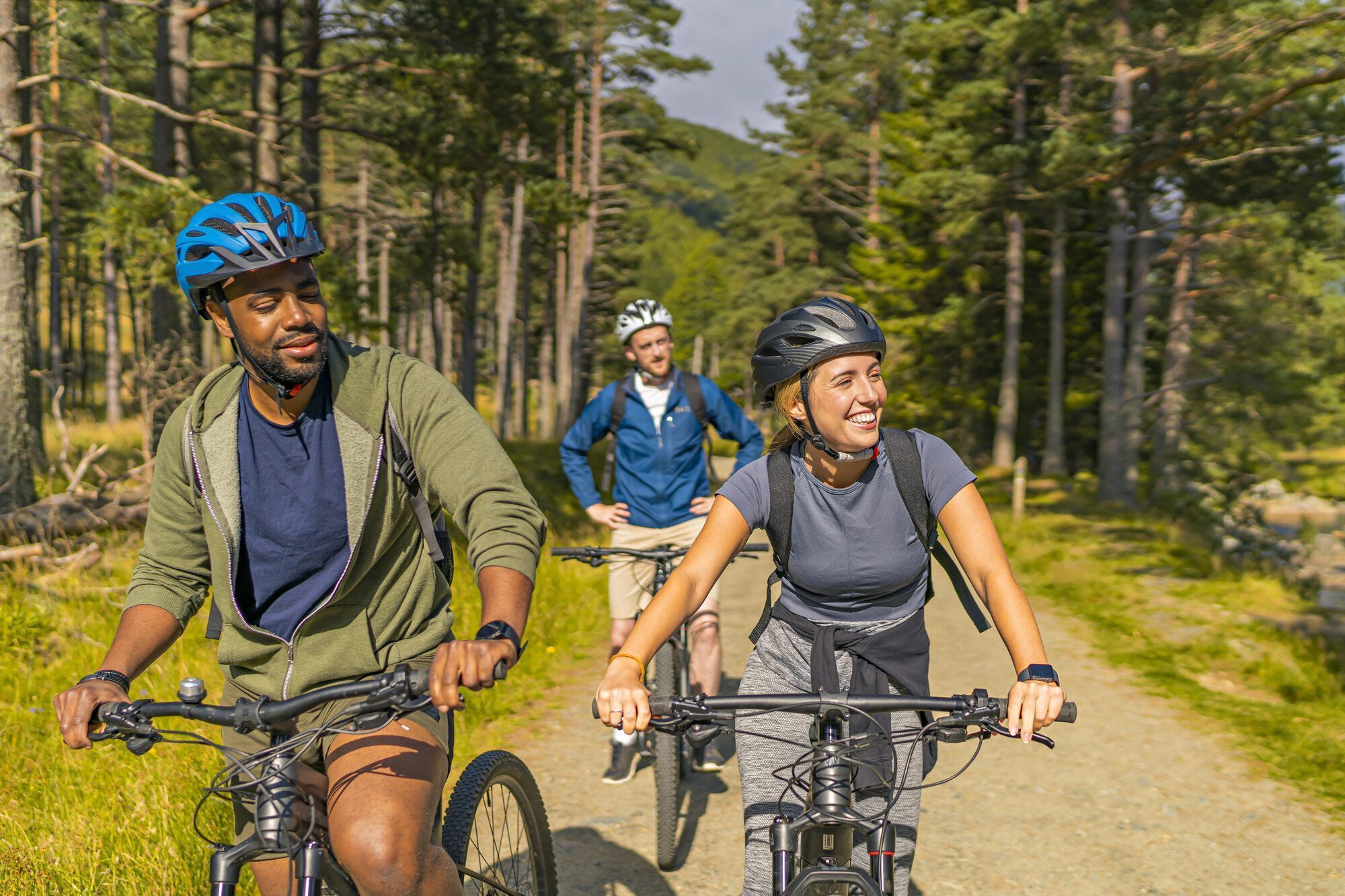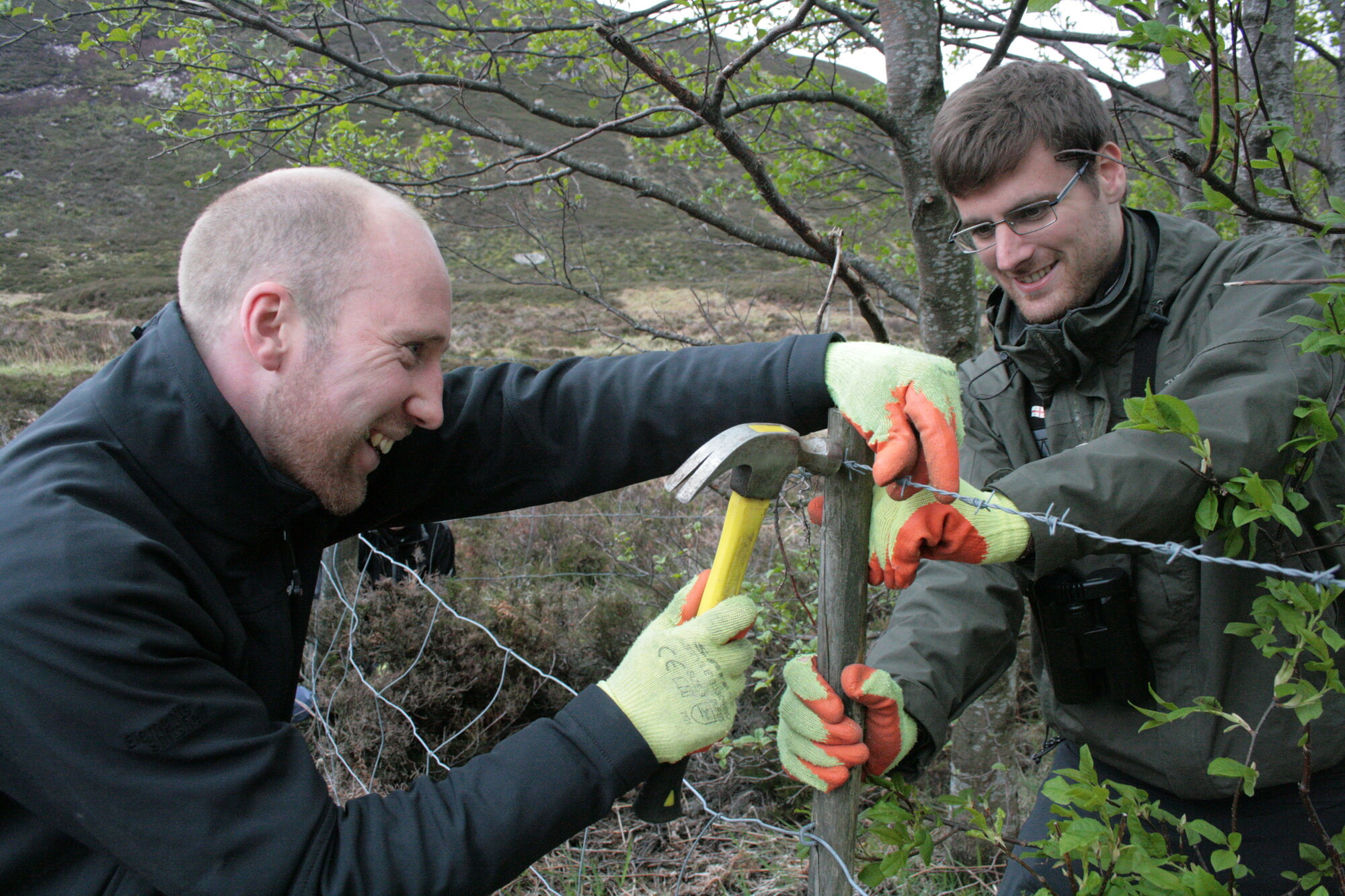STANTEC - Newtonmore A1 Event Panels
ACTIVE TRAVEL IMPROVEMENTS
As part of Heritage Horizons: Cairngorms 2030, an ambitious programme is underway to put active and sustainable travel at the heart of a greener future for the National Park.
The Cairngorms National Park Authority (CNPA) are working with local communities to make it easy and safe for residents and visitors to get around in villages in Badenoch and Strathspey without a vehicle. By improving active travel infrastructure and public spaces, we want to make it more enjoyable for everyone to walk, cycle or get around using a wheelchair.
Listening to local views and ideas will be central to developing the proposals. Initially the focus of this project is on five villages, whilst supporting other active travel initiatives currently ongoings in the area. Along with many other projects this work will place active travel at the heart of a greener and healthier future.
Take the Survey!
Please take the time to read through the survey and give us your ideas and comments about the current proposals and how you would like to see it improved in the future. It will take about 5 – 10 minutes.
You can access the survey on your personal device either through the link or the QR code found below.
Benefits of Active Travel
Economy — Although vehicle access is not unimportant in rural communities, studies have shown that providing easy and safe access for people not arriving by car can benefit the economy (e.g. Sustrans, 2016). Supporting activity-focused tourism based around walking and cycling with appropriate and safe infrastructure can contribute further to that.
Environment — In 2019 transport produced 27% of the UK’s total emissions. Of this, the majority (91%) came from road transport vehicles (DFT, 2019). Furthermore, with transport being one of the only sectors where emissions are rising, action is needed. A 2,000 person study by the University of Oxford found that those who switched from car-driving to cycling for just one trip per day reduced their carbon footprint by about 0.5 tonnes over a year.
Health — Walking, and physical activity generally, can reduce the risk of depression, dementia and Alzheimer’s and can help reduce the risk of disease progression for many serious health conditions such as heart disease and a variety of cancers (National Walking Strategy, 2014). Recent research, (Baker et al, 2021) outlined that walking and cycling makes up 13 – 15% of all commuting journeys in Scotland, bringing with it an annual economic health benefit of over £660m.
Equality — The modes of transport that people use are influenced by their income. Evidence shows that people in lower income households are more likely to take the bus, while people in higher income households are more likely to drive or take the train (Transport Scotland, 2018, 2019). An accessible local environment is fundamental to disabled people’s ability to both participate in their local community activities and to link into wider transport networks.
Safety — Reducing the number and speed of vehicles on our streets dramatically improves safety for both pedestrians and roads users. A recent study by the European Commission (2020) found that across it’s 27 member states, fatalities overwhelmingly occurred in collisions involving cars and trucks — highlighting the need to increase the protection of vulnerable road users such as pedestrians, wheelers and cyclists.
https://cairngorms2030.commonplace.is/
transport@cairngorms.co.uk
01479 873 535
COMMUNITY ENGAGEMENT
Engagement Process
In the second half of 2022, a comprehensive engagement exercise was undertaken to understand what active travel improvements the Newtonmore community would like to see made.
The stakeholder and community engagement is being informed by the preparation of an Equality Impact Assessment (EqIA).
Newtonmore
Commonplace Map
Promotional Poster
Cairngorms 2030 Roadshow
Newtonmore Health Walk Group “Walk and Talk” (August 2022)
Commonplace website (August / October 2022)
Community Engagement 2022
Postcards from the future (October 2022)
Community Event (August 2022)
Future Walks (October 2022)
Promotional Poster
Postcards form the Future
Future Walk
Commonplace Website
A Commonplace website was used to undertake an Active Travel Survey which asked a number of questions about how people currently travel and allowed them to comment on specific locations using an interactive map.
Engagement Findings
Results from the engagement helped from a long list of potential improvements aligned to where the community felt active travel improvements were most needed.
Notable interventions raised by the community were footway improvements along A86 Laggan Road and the NCN crossing on A86 Main Street.
As a part of the engagement exercise, the Newtonmore community was asked to indicate their sentiment towards the current active travel network in the community; scoring a range of themes from 1 to 10. The graphic on the right shows the results of the sentiment survey.
Identified Community Objectives
Improve safety for walking, cycling and using a wheelchair
Better connectivity with and between existing infrastructure
Better accommodate everyday journeys to shops, schools, services and employment by active travel
Improve public spaces and access to them
- 3 How safe is it to cycle around your community?
- 8 How many attractive and pleasant places exist in your community for people to spend time or meet others?
- 5 How do you rate the amount of traffic driving through your community?
- 8 How do you experience traffic speeds in your community?
- 7 How suitable are the pavements in your community for people with buggies, wheelchairs and other mobility aids?
DESIGN PROCESS
Potential Funding
The most likely source of funding is through Places for Everyone, a funding mechanism administered by Sustrans Scotland to allocate funding for active travel projects. The aim of Places for Everyone is to create safer, more attractive, healthier places by increasing the number of trips made by walking, cycling and wheeling for everyday journeys. Design principals guiding the development behind Places for Everyone are:
Develop ideas collaboratively and in partnership with communities
Facilitate independent walking, cycling and wheeling for everyone, including an unaccompanied 12 year old
Design places that provide enjoyment, comfort and protection
Ensure access for all and equality of opportunity in public space
Ensure all proposals are developed in a way that is context-specific and evidence-led
Reallocate road space, and restrict motor traffic permeability to prioritise people walking, cycling and wheeling over private motor vehicles
Design Process
The figure below sets out the design process:
1 — Engagement with local community to define problems and opportunities
Second half of 2022
Road Safety Audits
2 — Identify potential preferred improvements, based on reported need, impact and deliverability
Ecological Survey
3 — Prepare concept designs and test with stakeholders and community
Early 2023
Traffic Speeds/Volume Survey
4 — With further input from stakeholders and the community, viable concept designs are worked up in more detail (Detailed Design)
2023/2024 (Subject to securing funding)
Topographical Survey
5- Once all statutory permissions and other requirements are in place, a technical package is prepared (Technical Design)
6- Appoint a to construct the works (Construction)
2025 Onwards (subject to securing funding)
REDUCING TRAFFIC SPEEDS
What is Traffic Calming?
Traffic calming is normally used in residential and urban areas. Physical features are installed to reduce the speed and amount of traffic passing through an area to make roads safer for all road users. By doing this, the quality of the local environment can also potentially be improved.
Footway Build-outs
Mini Round-abouts
Encourage more walking and cycling
Reduce the number and severity of casualties resulting from road traffic collisions, especially those involving pedestrians and cyclists
Benefits of Traffic Calming
Discourage heavy vehicles and ‘through traffic’ from using unsuitable routes
Central Islands
Types of Traffic Calming
Road Humps
Provide a greater feeling of safety
Improve the urban street environment for local communities
Reduce speeding
Priority Junctions
Chicanes
If hit by a person driving at:
20 MPH — 90% Person Survives the Collision / 10% Results in a Fatality
30 MPH — 60% Person Survives the Collision / 40% Results in a Fatality
40 MPH — 20% Person Survives the Collision / 80% Results in a Fatality
Source: Vision Zero Two-Year Action Strategy
SAFETY AND ACCESSIBILITY
Challenges Faced by People with Impaired Mobility
The needs of all people are being considered when as part of this project. We know there are many challenges faced by people with mobility impairments which can cause them to be heavily dependant on others to help them move around. Creating and maintaining an accessible public realm is crucial for ensuring that disabled people are not excluded from playing a full role in society. Disabilities and impairments can come in many forms:
Mobility Impairments: includes people who use wheelchairs and those who can walk but only with difficulty, often using some form of aid such as a stick or walking frame.
Vision Impairments: vision impaired people include blind people and partially sighted people.
Hearing Impairments: RNID reports that there are 12 million people in the UK with hearing loss greater than 25dB, of whom 151,000 are British Sign Language (BSL) users (www.rnid.org.uk).
Limitations with Reaching, Stretching and Dexterity: these are frequently the result of arthritis, which can make these movements painful and difficult, or of muscular dystrophy causing a loss of muscular strength, or of complaints of the nervous system.
Neurological and Learning Differences: including those making it hard to understand complicated information or use complex machines (like some ticket machines).
According to the National Health Service (www.nhs.uk/conditions/vision-loss), there are almost 2 million people in the UK living with sight loss. Of these, around 360,000 are registered as blind or partially sighted.
Approaching 70% of disabled people have a mobility impairment; those with walking difficulties outnumber wheelchair users by about 10:1.
Although the main purpose of inclusive design is to provide good access for disabled people, designs that satisfy their requirements also meet the needs of many other people. People travelling with small children (including in prams) or carrying luggage or heavy shopping will all benefit from an accessible environment, as will people with temporary mobility problems (e.g. a leg in plaster) and many older people.
The photo above shows a location in Newtonmore, where a person is pushing someone in a wheelchair in the middle of the road where the footway is not wide enough for them.
Other mobility safe and inclusive design considerations include:
Tonal and colour contrast
Width and height clearance
Inclines / gradients
Ramps
Seating
Shared use routes
Street furniture
Surface materials and maintenance
Guardrails
Road crossings
Steps and stairs
Dropped kerbs and raised crossings
Street works and other potential hazards
Footbridges and underpasses
Platforms: rail services
RECOMMENDED INTERVENTIONS
A long list of options was created through engagement with the community and key stakeholders, site visits and a desktop review / baseline analysis of the existing transport infrastructure and travel characteristics within Newtonmore.
An option appraisal was then undertaken to rank and identify priority options, with options being assessed against a range of community objectives and the deliverability of each option. The map below shows the options which are recommended to be considered to be taken forward.
Identified schemes
Easy wins
- NM3 A86 Main Street NCN Crossing
- NM4 Gateways Approaching Newtonmore (OUT OF MAP EXTENTS)
- NM6 Improved access to Centenary Garden
- NM11 A86 Laggan Road Connection
- NM12 A86 Laggan Road Footway
- NM18 Speed Limit Enforcement on A86
- NM20 Primary School Pedestrian Crossing
- NM21 A86 Laggan Road / Station Road Junction
- NM23 Electronic Speed Sign on A86 Main Street Gateway
- NM24 New Pedestrian Crossing on A86 Laggan Road
Improve Pedestrian Access and Safety along A86 Laggan Road
This work will look to address safety concerns and accessibility issues along A86 Laggan Road, by delivering interventions NM11, NM12, NM18, NM21 and NM24
These recommended options to be taken forward are being developed further into concept designs. The options that have not been taken forward remain valid and could be considered further at a later date.
CROSSINGS AND TRAFFIC CALMING
A number of locations for improved crossings have been identified with a view to creating a safer environment for pedestrians, particularly vulnerable road users such as older people, children and those who identify as having a disability.
Some of the options for pedestrian crossings also act as traffic calming features. In addition, other traffic calming features could be provided. Traffic calming has been shown to increase safety for cyclists on the road by reducing vehicle speeds.
| Real World Example | Type | Description | Pros and Cons |
|---|---|---|---|
| * | 1. Dropped Kerbs (not at junctions) | These provide step free crossings, they could be accompanied by a different material across the road to indicate to drivers that people are likely to be crossing the road at this point. | Pros: Minimal changes to the lay-out mean these would be suitable in places where traffic speeds are already suitably low. Cons: drop kerbs involve lowering the footway to the same level as the road; this makes the footway uneven which is difficult to navigate for some people such as wheelchair users and it can become an increased hazard during sub-zero temperatures. |
| * | 2. Dropped Kerbs (at junctions) | ||
| * | 3. Raised Crossing | Pros: These types of crossing are useful in places where traffic speeds make people feel unsafe when crossing the road. Like drop kerbs, the raised features provide step free crossings which are better for people with mobility impairments, people in wheelchairs and people pushing prams. Vehicles are encouraged to slow down. These types also do not have the drawbacks of the drop kerbs. | |
| * | 4. Raised Table (junctions) | The road is raised to footway level. This can be across the main road, at side road or over the whole junction. | |
| * | 5. Continuous Footway Crossover (junctions) | The raised crossing makes is more obvious to drivers that it is a place people may be crossing the road. Cons: these types of features may require more maintenance compared to drop kerbs. | |
| * | 6. Controlled Crossing (not at junctions) | This could be traffic lights or a zebra crossing. | Pros: these give more priority to pedestrians and / or are safer for pedestrians, particularly vulnerable road users Cons: there is an increase cost in terms of construction and maintenance. |
| * | 7. Pavement Build Outs / Lane Deflection (not at junctions) | Pros: these features slow vehicles making it a safer environment, particularly for people cycling. Cons: these features do not work so well in places with a high numbers of vehicles passing through. | |
| * | 8. Pavement Build Outs / Lane Deflection / Pedestrian Crossing | The image shows lane deflection. |
PATHS AND PUBLIC REALM
Path Examples
Below are some examples of materials that could be used to construct footpaths.
When choosing the surface type it is important to consider issues such as cost, drainage and maintenance and a material that is within the character of the surroundings. Even a bitmac surface will not be totally maintenance free; they do need inspecting and some planned, routine maintenance during their useable lives.
Bound surfaces
Semi-bound surfaces
Bitmac Path
- very durable, easy to maintain and suitable for most path user types, allowing all year-round use
- more comfortable for use by cyclists and wheelchair users due to the very smooth finish
- lower annual maintenance liability due to high levels of durability
- can be applied to steep ramps where it will resist water scouring far better than unbound and semi-bound materials
- relatively simple to repair damage (e.g. potholes) than some other bound surfaces
- experienced ‘tarring’ contractors are readily available throughout Scotland
- typical lifespan of 30+ years
Resin bound
Cedec path
- 100% recycled and inert product made from screened construction waste, blaes and road planings
- a suitable and cost-effective alternative to unbound surfaces or where a bound surface is either too expensive and/or not aesthetically acceptable
- highly durable surface and especially suited to woodland paths where water dripping off trees would quickly ‘wash out’ an unbound surface
- lower installation costs than a bound surface
- relatively straightforward to maintain and repair areas of restricted damage
- typical lifespan of 10 – 15 years
Ultitrec path
Public Realm Examples
Below are some examples of public space improvements that could be incorporated.
Metal frame interpretation panel
Stone orientation panel
Information board
Wooden way-marker
Bridleway plaque on wood sign
Metal fingerpost
Carved stone directional sign
NCN sticker on post
Information board
Gateway panel
A86 LAGGAN ROAD IMPROVEMENTS
NM11 – A86 Laggan Road Connection
NM12 – A86 Laggan Road Footway
NM21 – A86 Laggan Road / Station Road Junction
NM24 – New Pedestrian Crossing on A86 Laggan Road
Provide continuous footway connecting to properties on northside of carriageway from start of Laggan Road to Calder path and then on to Calder bridge. Provide pedestrian crossings located on A86 Laggan Road by Clan Macpherson Museum and by Station Road to allow pedestrians to cross safely.
A86 Laggan Road West
- INSTALL NEW 3M WIDE FOOTWAY
- POTENTIAL TO INSTALL CONTINUOUS (RAISED) FOOTWAY CROSSING OR DROPPED KERBS WITH TACTILE PAVING
- INSTALL NEW 2M WIDE FOOTWAY
- POTENTIAL TO INSTALL CONTINUOUS (RAISED) FOOTWAY CROSSING OR DROPPED KERBS WITH TACTILE PAVING
- POTENTIAL PEDESTRIAN CROSSING (TYPE ΤΟ ΒΕ CONSIDEREDI
- POTENTIAL TO INSTALL CONTINUOUS (RAISED) FOOTWAY CROSSING OR DROPPED KERBS WITH TACTILE PAVING
A86 Laggan Road East
- INSTALL NEW 3M WIDE FOOTWAY
- POTENTIAL TO INSTALL CONTINUOUS (RAISED) FOOTWAY CROSSING OR DROPPED KERBS WITH TACTILE PAVING
- INSTALL NEW 2M WIDE FOOTWAY
- POTENTIAL TO INSTALL CONTINUOUS (RAISED) FOOTWAY CROSSING OR DROPPED KERBS WITH TACTILE PAVING
- POTENTIAL PEDESTRIAN CROSSING (TYPE TO BE CONSIDERED)
- INSTALL PAVEMENT BUILDOUT TO FACILITATE SAFE CROSSING
Crossing Examples
Dropped Kerbs (at junctions)
Raised Table (junctions)
Continuous Footway Crossover (junctions)
Do you agree that a footway should be provided at this location?
What type of crossings should be provided (see examples)?
What else should be considered at this location?
A86 MAIN STREET NCN CROSSING
NM3 – A86 Main Street NCN Crossing
Provide pedestrian crossing with appropriate signage between the A86 Main Street footway and the entrance to the NCN footpath to allow active travel users to cross safely.
Option A
- NEW “CYCLIST CROSSING SIGNS TO BE INSTALLED ON EXISTING CYCLIST SIGN POLES ON BOTH SIDES OF CROSSING
- SHORTEN PATHWAY AND PROVIDE POTENTIAL PEDESTRIAN CROSSING (TYPE TO BE CONSIDERED) SO NORTH SIDE OF CROSSING IS ON NEW FOOTWAY BUILDOUT
- Workbook last saved: 4m ago
- INDICATIVE LAND BOUNDARY.
- ENTRANCE SO USERS CROSS AT NEW CROSSING. OPPORTUNITY FOR IMPROVED PUBLIC REALM
- REPURPOSE EXISTING PATHWAY
- LEGEND
- EXISTING FOOTWAY
- NEW FOOTWAY
- PEDESTRIAN CROSSING
- IMPROVED PUBLIC AREA
- TACTILE PAVING
- PROPERTY BOUNDARY
Option B
- NEW “CYCLIST CROSSING SIGNS TO BE INSTALLED ON EXISTING CYCLIST SIGN POLES ON BOTH SIDES OF CROSSING
- LEGEND
- EXISTING FOOTWAY
- NEW FOOTWAY
- PEDESTRIAN CROSSING
- IMPROVED PUBLIC AREA
- TACTILE PAVING
- PROPERTY BOUNDARY
- REPURPOSE EXISTING PATHWAY ENTRANCE TO FORCE USERS TO CROSS AT NEW CROSSING
- INDICATIVE LAND BOUNDARY, POTENTIAL LAND ACQUISITION REQUIRED
- A86
- HIGHLAND FOLK MUSEUM
- POTENTIAL TO INSTALL CONTINUOUS (RAISED) FOOTWAY CROSSING OR DROPPED KERBS WITH TACTILE PAVING
- EXTEND PATHWAY AND PROVIDE POTENTIAL PEDESTRIAN CROSSING TYPE TO BE CONSIDERED) SO NORTH SIDE OF CROSSING IS ON FOOTWAY
Do you agree that an improved crossing for pedestrians should be provided at this location?
Which option do you prefer? Please explain your answer.
What else should be considered at this location?
CENTENARY GARDENS ACCESS
NM6 – Improved Access to Centenary Gardens
Provide improved pathway connection to Centenary Garden, extending to Newtonmore Golf Club.
Path Surface Examples
Bitmac Path
Resin bound aggregate
Cedec path
Ultitrec path
NEWTONMORE VILLAGE HALL
NEW 3M WIDE FOOTPATH THROUGH CENTENARY GARDENS TO GOLF CLUB
EQUALITY ACT COMPLIANT RAMP (SUBJECT TO CONFIRMATION OF GRADIENT)
NEWTONMORE GOLF CLUB
Do you agree that an improved footpath should be provided at this location?
What type of footpath should be provided (see examples)?
What else should be considered at this location?
SCHOOL PEDESTRIAN CROSSING
NM20 – Primary School Pedestrian Crossing
Provide pedestrian crossing and improved signage in front of Newtonmore Primary School.
Crossing Examples
Dropped Kerbs (not at junctions)
Raised Crossing (not at junctions)
Controlled Crossing (not at junctions)
Pavement Build Outs / Lane Deflection / Pedestrian Crossing
NEW ‘CHILDREN CROSSING WARNING SIGNS TO BE INSTALLED, SITING DISTANCE OF SIGN FROM CROSSING POINT TO BE DETERMINED FROM MEASURED TRAFFIC SPEEDS
POTENTIAL PEDESTRIAN CROSSING (TYPE TO BE CONSIDERED)
Do you agree that an improved crossing should be provided at this location?
What type of crossing should be provided (see examples)?
What else should be considered at this location?




